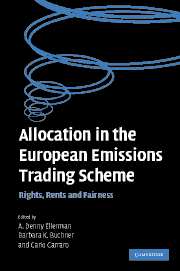Book contents
- Frontmatter
- Contents
- List of figures
- List of boxes
- List of tables
- List of contributors
- Introductory note/Foreword
- Acknowledgements
- Glossary and abbreviations
- Part I The EU ETS allocation process
- Part II Experiences from Member States in allocating allowances
- 3 United Kingdom
- 4 Germany
- 5 Denmark
- 6 Sweden
- 7 lreland
- 8 Spain
- 9 Italy
- 10 Hungary
- 11 Czech Republic
- 12 Poland
- Part III Concluding remarks and background material
- Appendix I Participants
- Appendix II The individual country outlines
- Appendix III The country tables
- Appendix IV Background material from the European Commission
- Index
6 - Sweden
Published online by Cambridge University Press: 22 September 2009
- Frontmatter
- Contents
- List of figures
- List of boxes
- List of tables
- List of contributors
- Introductory note/Foreword
- Acknowledgements
- Glossary and abbreviations
- Part I The EU ETS allocation process
- Part II Experiences from Member States in allocating allowances
- 3 United Kingdom
- 4 Germany
- 5 Denmark
- 6 Sweden
- 7 lreland
- 8 Spain
- 9 Italy
- 10 Hungary
- 11 Czech Republic
- 12 Poland
- Part III Concluding remarks and background material
- Appendix I Participants
- Appendix II The individual country outlines
- Appendix III The country tables
- Appendix IV Background material from the European Commission
- Index
Summary
Introductory background and context
The development of Swedish energy use and climate policy
Important change in energy use since the 1970s
The energy supply in Sweden has changed dramatically since the 1970s. The major change has been the decrease in oil from 77% of the total energy supply in 1970 to 33% in 1997. This change was made possible mainly thanks to the development of hydro power and the nuclear programme. Also, the use of bio-fuels and peat has increased from 9% of the total supply in 1970 to 15% in 1998. Energy consumption has been reduced in the industry and housing sectors and increased within transportation between 1970 and 1998. It is mainly the use of oil that has been reduced in the industry and housing, and increased in transport. The use of electricity has increased considerably within industry and housing (SOU 2000a).
High use of energy
Sweden has a relatively high energy use per capita in comparison with other OECD countries. In 1997 the average energy use per capita was 17,000 kWh as compared to 7,500 kWh in the OECD. This can mainly be attributed to the fact that Sweden has natural resources such as forest, iron ore and hydropower, which in turn has resulted in a large share of energy-intensive industry. The geographical position and low population density has contributed to Sweden having large heating needs and long transportation distances.
- Type
- Chapter
- Information
- Allocation in the European Emissions Trading SchemeRights, Rents and Fairness, pp. 132 - 156Publisher: Cambridge University PressPrint publication year: 2007
- 3
- Cited by

